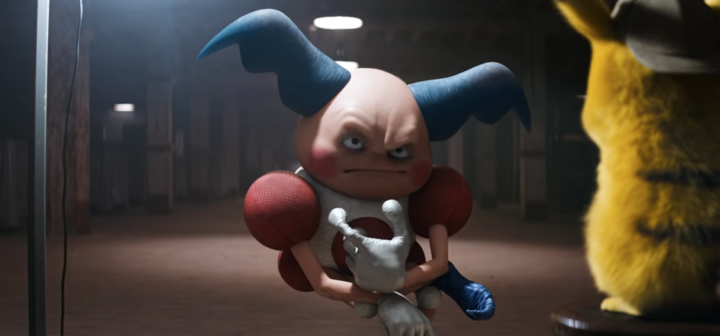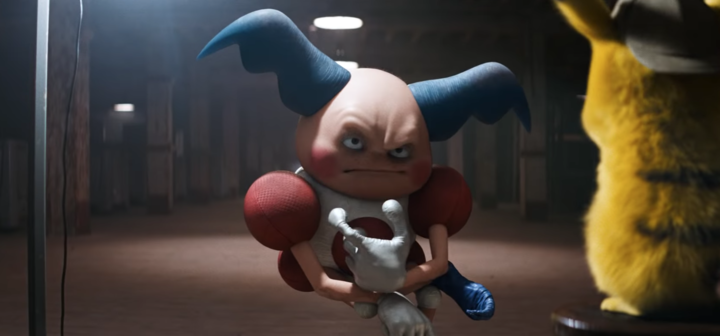[ad_1]
The “Detective Pikachu” trailer is out, and it’s terrifying!
The movie, based on the video game of the same name, revolves around Pikachu (voiced by Ryan Reynolds), who’s teamed up with the only human person who can understand him (Justice Smith as the character Tim Goodman) to solve crimes.
All right, the plot sounds innocuous enough. But unlike the classic animated 2D versions of “Pokemon,” this movie is live action, filled with realistic-looking CGI creatures ― some of which are the brain children of the designers who put together those “real” Pokémon lists.
And those realistic creatures are freaking people the heck out.
There’s no denying it. “People are freaked out by Mr. Mime,” and “Furry Jigglypuff” has certainly garnered “mixed reviews.” But why?
HuffPost reached out to a number of experts in psychology and design to get to the bottom of our collective chills, and some of their answers were more onix-pected than others. Here are a few reasons realistic Pokémon feel like waking nightmares:
The uncanny valley.
One of the most compelling theories speculated on offered by psychologists and designers alike is: We’re in “uncanny valley” territory.
The term “uncanny” has roots in an essay by Sigmund Freud in 1919 called “Das Unheimliche,” explained Ken Goldberg, a professor and department chair of industrial engineering and operations research at University of California, Berkeley.
“This idea of the uncanny has a lot of interesting resonance in a lot of classic gothic literature and a lot of art, and it’s used by artists through history,” he said. “It’s where you have something that is normally familiar and then it becomes deeply unfamiliar.”
Goldberg said the term “uncanny valley” came about in 1970 when roboticist Masahiro Mori made a conceptual discovery while looking into how people react to prosthetics. The “more humanlike” artificial limbs got, Goldberg said, the “more comfortable up to a point” people were around them.
“And then there’s this big dip.”
The thing was, even though the robotic work so closely resembled human limbs, they weren’t absolutely convincing as human limbs. And that made people feel, well, weird. Think of a classic creep-fest like “Polar Express.” The closer a character in the animated movie appears to a human, the more you feel like Tom Hanks wants to murder you.
“When people start talking about using the term creepy, it’s a good signal,” Goldberg said of the critics bemoaning the too-real Pokémon appearances. “Because creepy is the closest thing we have to the emotion of the uncanny, that Freud talked about. We don’t have a word for it in English, but creepy is pretty close. So it could be called the creepy valley, right?”
The uncanny valley isn’t a perfect theory to explain the eeriness of the CGI Pokémon, though.
Peter Lunenfeld, a professor and vice chair in the design and media arts department at UCLA, told me it’s “a little bit odd” that people are bringing up the uncanny valley to describe how they feel about the Pokémon, because the concept applies to images that are “trying to approach a human” and Pokémon were never real.
In this case, he said, the term “uncanny valley” isn’t being used as its definition intended. Rather, it’s acting like a meme.
“You can identify the uncanny valley now as a meme. It’s not something that has that much relationship to the scientific or academic literature, but they want to invoke why it feels creepy to them,” he said.
According to Lunenfeld, there are different ways into the uncanny valley.
“Walt Disney approaches the uncanny valley from the classic route, which is with the Hall of Presidents and animatronics, whereas somebody like Hugh Hefner approaches the uncanny valley in the opposite direction, where he takes real people, i.e. playmates, and turns them into denizens of the uncanny valley,” he said, reiterating an idea he’d outlined in the essay “The Factory Model of Desire.”
“This is yet another route to the uncanny valley, where 8-bit characters turn into illustrations on cards who then turn into anime who were then turned into various [3-D generations] of gaming,” he said.
He added, “The question is, ‘Why when you get to this moment, literally 30 years after the first thought of [Pokémon]… why is it that this iteration in this particular narrative space breeds this online discussion?’”
Part of the discussion hinges on a character that perhaps better fits the traditional definition of the uncanny valley: Mr. Mime, a humanoid demon-clown-jester-looking Pokémon. Of all the characters in the trailer, Mr. Mime is probably the creepiest, and Goldberg explained why.
“This particular guy… he does look a little like an evil clown and has got this fleshiness to him,” he said. “The little hairs on his head are particularly troubling people, and that is often a sign. This little bit of realism that goes to far.”

Warner Bros.
Elizabeth Jochum, an associate professor in art practice and robotics at Aalborg University in Denmark, agreed.
“I think that has to do with the creepy human factor where it’s somewhere in between. We don’t know where to put it. It’s not quite animated, and it’s not quite fantastical, and it’s not quite human,” she said. “The other thing is we’re trying to understand what it says, but we don’t really understand it.”
We also went to someone who’s studied what actually makes things creepy, Frank McAndrew, a professor of psychology at Knox College in Illinois. He admitted that Mr. Mime’s face is working against him.
“The eyes in particular, with the eyebrows going up ― very expressive, very human-looking,” he said. “But there’s no nose and no lips and no teeth, so once again you’ve got this [conflict]… if you just were to focus on the eyes and the eyebrows you would think it actually is a human being, but then it’s embedded in this other thing where you don’t even know what it is. Think of it as a cognitive tension.”
“You know we don’t like uncertainty,” he continued. “We want to be able to categorize these things, so we look at something like this and we struggle. Because what the hell is it is it supposed to be? A person? Is it supposed to be something else? We don’t know.”
Expectations.
Jochum provided us with a few other thoughts on the Pokémon heebie-jeebies.
“I found it uncanny for another reason, which had to do with the voice ― which completely did not mix at all with the Pikachu design or with previous kinds of iterations of Pikachu that we know from film or the Japanese anime. In that regard, I think the uncanny is triggered by this dissonance between this cute little animated character and the voice of this middle aged man.”
Again, Pikachu is voiced by Ryan Reynolds, age 42.
Like the shock of hearing a deep voice come out of a yellow electrified rodent, some of our creeped-out-ness has to do with plain ol’ expectations.
Here’s Jigglypuff from the animation:
Here’s Jigglypuff in the movie:
A lot of the experts we talked with didn’t find the Pokémon all that particularly disturbing.
“I gotta say, in the universe of creepy things, I think Pokémon are pretty far down the list,” McAndrew said.
But that’s because he didn’t have a history with them.
″Uncanny literary means ‘unfamiliar’ ― and is provoked when we are met with something that should be familiar to us but we experience as unfamiliar,” Jochum said. “So, it’s not about nostalgia, per se, but about the dissonance or discomfort we experience when we encounter something we think we know, but doesn’t match up to our expectations.”
“It’s not the uncanny valley so much, or even the unheimlich (the Germans have the best words for being creeped out),” Lunenfeld said, “as the unhappiness a subset of the Pokémon ‘community’ feels with this 3D-motion-capture-CGI-furred-celebrity-actor-voiced Pikachu. This unhappiness is driven by a mixture of nostalgia and unfulfilled desire. If I were to come up with a word for it, I’d call it ‘fannui’ which combines ‘fan’ with ‘ennui,’ which is a kind of exhaustion.”
“I think the issue here is also about the development and endless mutations and power of contemporary fan culture,” he said, “where people are both desperate to have all of the juvenilia turn into new entertainment, but they want their juvenilia to be exactly the way they want it.”
Dialectical opposition, aka people just want to be turds.
Still another reason for the backlash could be that people just like their backlash.
“Part of the reason is simply there’s nothing in pop culture right now that doesn’t bring about some sort of dialectical opposition move,” Lunenfeld concluded. “Whatever comes up, somebody is going to say I love it, somebody is going to say I hate it.”
The good news for future Pokémon trainers.
Whether you found the Pokémon uncanny or not, some people online confessed that after watching the trailer repeatedly they ended up enjoying the designs, because the effects from uncanniness wore off over time.
“We’re no longer afraid of it,” Jochum said, “because our brain tells us to be afraid of things we can’t really distinguish. The uncanny really is a physical response, and it is connected to our fight or flight mechanism. Is it friendly? Can I eat it? Is it going to eat me? Our brain makes very quick decisions about these things, and if we can’t immediately recognize if it’s friend or foe, human or non-human, then we have trouble with it and we stay on our guard.”
Sure, repeated viewings of the trailer might take the edge off dear Pikachu. We still choose you, buddy… eventually.
[ad_2]
Source link


 (@Trickywii)
(@Trickywii) 